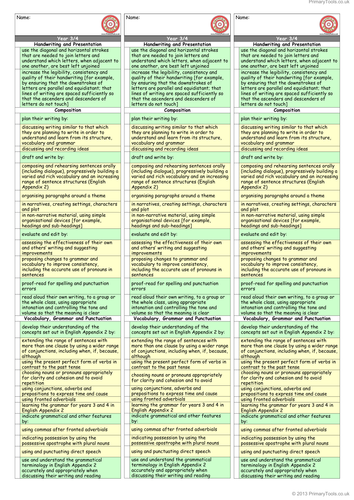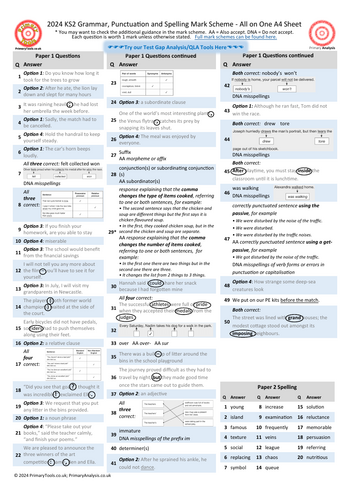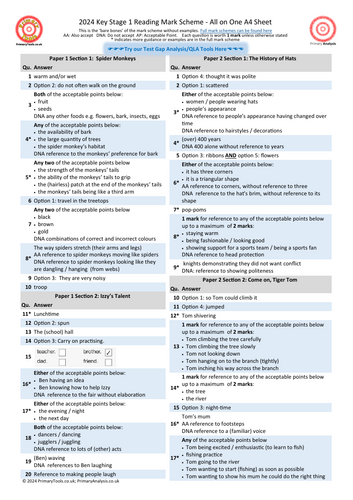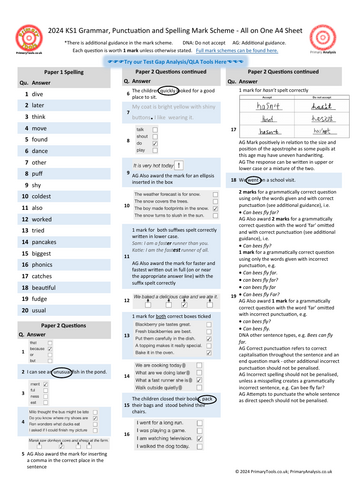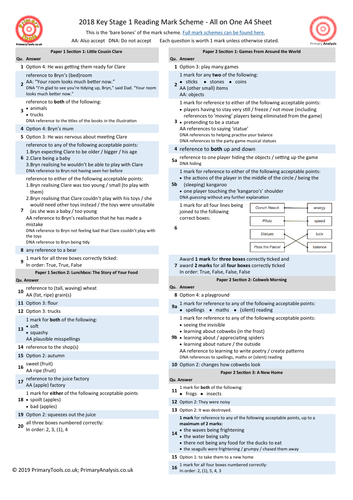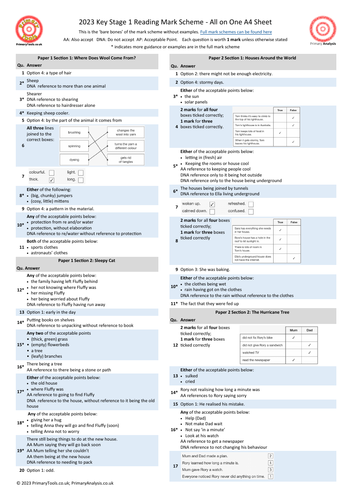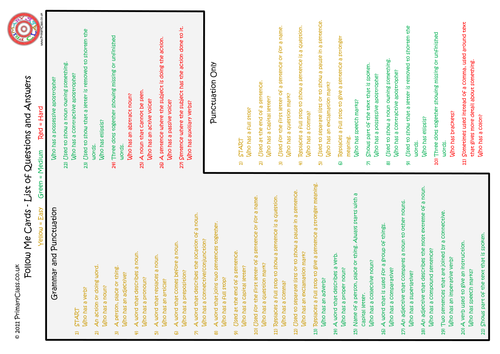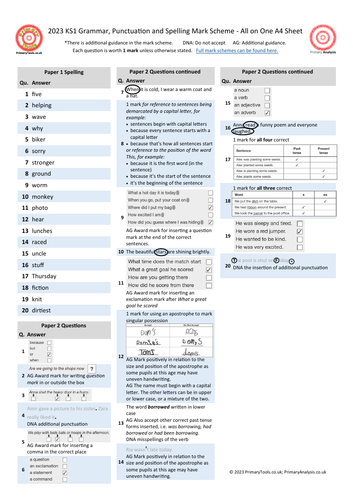
284Uploads
2075k+Views
2041k+Downloads
English

2024 KS2 Reading Test and Question Level Analysis
Summary of Features:
Pupil Summary shows total marks for each paper, number of questions unanswered (possibly indicating need to increase pace), number of incorrect answers, total overall score (and percent), total score in each strand. Option to adjust the colour thresholds to make it easier to spot patterns and gaps. All Versions from 2016.
Pupil Reports show a summary of performance in each strand for an individual pupils. Useful for feeding back to pupils, parents and informing intervention teachers. All Versions from 2016.
Contextual Analysis shows a breakdown by key groups (gender, SEND status, disadvantaged, EAL) plus up to four custom groups. Compares school data (grades and scaled scores) to national data in a detailed but user-friendly report. All Versions from 2016.
Cohort Summary shows an overview of the cohort against each strand. This is also compared to national data where it is available. This page gives a summary of attainment including number and percent at expected and higher standard. All Versions from 2016.
Strand Summary shows a the weighting of each strand and the performance within it. For example, in a grammar test a cohort may perform poorly in identifying sentence types and equally poorly in identifying punctuation. However as there is more weighting given to punctuation, it would be advisable to focus on this area. All Versions from 2016.
Other Charts Charts which show performance for each question, organised by most correct to incorrect, by strand and also by year group question (for mathematics). The most powerful chart orders questions from most correct to incorrect enabling you to see precisely where there are strengths and weaknesses. All Versions from 2016.

Curriculum 14: Yr 3/4 Writing Assessment Bookmarks
For Year 3/4: These materials are designed to support teaching and setting targets using the programmes of study for English Curriculum 2014. Colour and black and white versions. They are recommended for teacher use, I will be working on child/parent friendly versions in the near future.

2024 KS2 SATs Grammar, Punctuation and Spelling Test Mark Scheme on a Page
2024 KS2 SATs Grammar, Punctuation and Spelling Test Mark Scheme on a Page

2024 KS1 SATs Grammar, Punctuation and Spelling Test Mark Scheme on a Page
2024 KS1 SATs Grammar, Punctuation and Spelling Test Mark Scheme on a Page

2024 KS1 Reading Test and Question Level Analysis
2024 KS1 Reading Test and Question Level Analysis
Requires Excel with macros enabled.
Instant download after purchase. Maximum of 5 downloads.
Please note sample pictures are for the KS2 Mathematics Analysis.
Summary of Features (please note some features may not be available depending on the test type):
Pupil Summary shows total marks for each paper, number of questions unanswered (possibly indicating need to increase pace), number of incorrect answers, total overall score (and percent), total score in each strand. Option to adjust the colour thresholds to make it easier to spot patterns and gaps.
Pupil Reports show a summary of performance in each strand for an individual pupils. Available in 2016 versions and later. contain detailed feedback on each question. Useful for feeding back to pupils, parents and informing intervention teachers.
Contextual Analysis (2016 versions onwards) shows a breakdown by key groups (gender, SEND status, disadvantaged, EAL) plus up to four custom groups. Compares school data (grades and scaled scores) to national data in a detailed but user-friendly report.
Cohort Summary shows an overview of the cohort against each strand. This is also compared to national data where it is available. This page gives a summary of attainment including number and percent at expected and higher standard.
Strand Summary shows a the weighting of each strand and the performance within it. For example, in a grammar test a cohort may perform poorly in identifying sentence types and equally poorly in identifying punctuation. However as there is more weighting given to punctuation, it would be advisable to focus on this area.
Other Charts Charts which show performance for each question, organised by most correct to incorrect, by strand and also by year group question (for mathematics). The most powerful chart orders questions from most correct to incorrect enabling you to see precisely where there are strengths and weaknesses.
2024 KS1 Reading Test and Question Level Analysis (SATs)

Tracker for the Decimal Assessment Systems (Writing, Reading and Mathematics)
Free tracker now available for the Decimal Assessment System.
A complete tool for tracking attainment and progress.
Powerful filtering tools and report/charts to aid analysis of groups and classes.
Most up to date versions will always be on Primary Tools website.
Requires Excel 2010 or later.

2016 KS2 Reading Test Electronic Analysis
Produces easy on the eye tables and charts for cohorts and individuals. Broken down into areas of learning and specific question performance.
Up to 400 pupils (works best in Excel 2010 or later with macros enabled)
Versions also available for Grammar, Punctuation and Spelling, and also Mathematics:
GPS: https://www.tes.com/teaching-resource/2016-ks2-grammar-punctuation-and-spelling-test-electronic-analysis-11291706
Maths: https://www.tes.com/teaching-resource/2016-ks2-mathematics-test-electronic-analysis-11291695

The Great Spelling Race
Fast and fun - rich, engaging, highly active and effective race on commonly misspelt words. Ideal for quick booster sessions.
Approx 30 minute race for a whole class with minimal preparation.
Includes instructions, race sheets, word lists and test sheets.

Test Analysis for 2016 KS1 Sample for Reading
Test Analysis for 2016 KS1 Sample for Reading: Up to 550 pupils with individual pupil reporting (works best in Excel 2010 or later with macros enabled).

2018 KS1 National Curriculum (SATs) Test Analysis for Reading
2018 KS1 National Curriculum (SATs) Test Analysis for Reading.
Please see release notes for new features.
Analysis for all tests is available elsewhere on TES or from our website.

KS1 and KS2 2018 Grammar Punctuation and Spelling Mark Scheme on a Page
KS1 and KS2 2018 Grammar Punctuation and Spelling Mark Scheme on a Page

On One A4 Sheet: Key Stage 2 Teacher Assessment Framework from 18/19 and Pre-Key Stage 2 Standards
On One A4 Sheet:
Key Stage 2 Teacher Assessment Framework from 2018/2019 and Pre-Key Stage 2 Standards for Writing, Reading, Mathematics and Science

Punctuation 'Follow Me' Loop Card Game/Quiz
Printable game to play with your class to help with understanding punctuation. elementary-class.com

2023 KS1 SATs Grammar, Punctuation and Spelling Test Mark Scheme on a Page
2023 KS1 SATs Grammar, Punctuation and Spelling Test Mark Scheme on a Page

2023 KS1 SATs Reading Test & Comprehensive Question Analysis Tool
Boost Success: 2023 KS1 Reading Test & Question Analysis (Excel with Macros)
Summary of Features (features may vary based on test type):
Pupil Summary: View total marks, unanswered questions, incorrect answers, overall score, and scores in each strand. Customize color thresholds for pattern spotting.
Pupil Reports: Provide feedback on performance in strands and per question.
Contextual Analysis: Breakdown by key groups (gender, SEND, disadvantaged, EAL) and compare to national data.
Cohort Summary: Overview of cohort’s performance and compare to national standards.
Strand Summary: Weighting of strands and performance analysis.
Other Charts: Charts showing question performance and strengths/weaknesses.
Experience the power of this 2023 KS1 SATs Reading Test & Question Analysis Tool for educational insights, interventions, and student achievement.

2019 KS2 Reading Test Gap Analysis and Pupil Reporting
2019 KS2 Reading Test Gap Analysis and Pupil Reporting

2022 KS2 Reading Test and Question Level Analysis
2022 KS2 Reading Test and Question Level Analysis
Requires Excel with macros enabled.
Summary of Features (please note some features may not be available depending on the test type):
Questions Versus National compares the performance of your cohort against the performance of pupils nationally in each question. A powerful chart which instantly shows you which questions you are strong or weak on. As it uses national data, it considers the difficulty of each question, compares it the performance of your cohort and orders the results from strongest to weakest. 2016 to 2022 KS2 versions only, Q vs National will be added to the 2023 KS2 version at a later date.
Pupil Summary shows total marks for each paper, number of questions unanswered (possibly indicating need to increase pace), number of incorrect answers, total overall score (and percent), total score in each strand. Option to adjust the colour thresholds to make it easier to spot patterns and gaps.
Pupil Reports show a summary of performance in each strand for an individual pupils. Available in 2017 versions and later excluding reading. 2018 versions and later contain detailed feedback on each question. Useful for feeding back to pupils, parents and informing intervention teachers.
Contextual Analysis (2019 versions onwards) shows a breakdown by key groups (gender, SEND status, disadvantaged, EAL) plus up to four custom groups. Compares school data (grades and scaled scores) to national data in a detailed but user-friendly report.
Cohort Summary shows an overview of the cohort against each strand. This is also compared to national data where it is available. This page gives a summary of attainment including number and percent at expected and higher standard.
Strand Summary shows a the weighting of each strand and the performance within it. For example, in a grammar test a cohort may perform poorly in identifying sentence types and equally poorly in identifying punctuation. However as there is more weighting given to punctuation, it would be advisable to focus on this area.
Other Charts Charts which show performance for each question, organised by most correct to incorrect, by strand and also by year group question (for mathematics). The most powerful chart orders questions from most correct to incorrect enabling you to see precisely where there are strengths and weaknesses.
2022 Reading SATs


